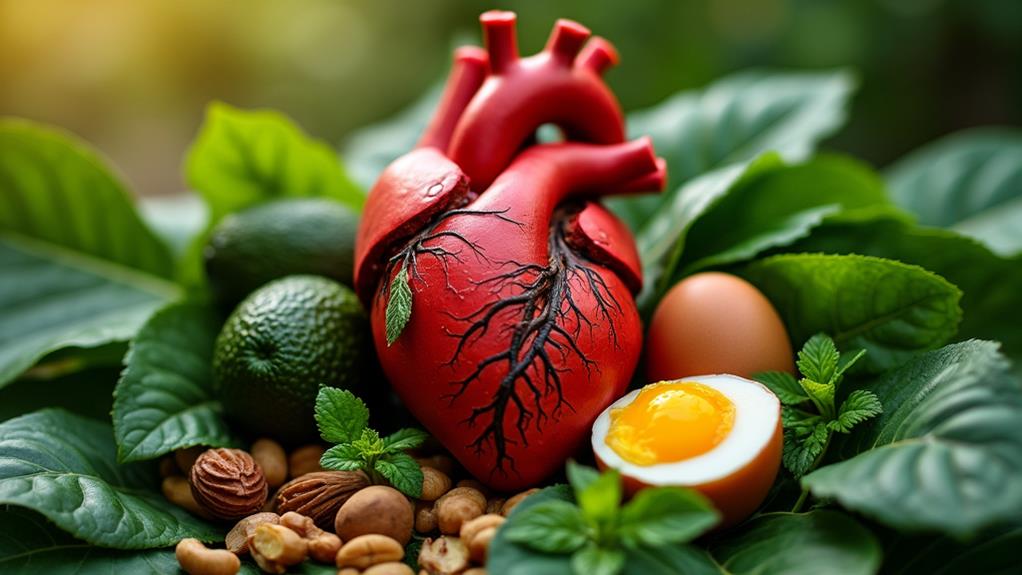







Yes, vitamin E can help reduce menstrual cramps. It works by targeting the prostaglandins that cause pain and has anti-inflammatory properties. Research indicates that supplementing with 200 to 400 IU of vitamin E daily can lead to a 25% reduction in pain levels, especially when taken two days before your period. It may not be as effective as NSAIDs but serves as a valuable complementary approach. Just be cautious if you're on blood thinners. For better results, consider pairing vitamin E with omega-3 fatty acids and vitamin C. You might find even more helpful insights on this topic.
Key Takeaways
- Vitamin E may reduce menstrual cramps by inhibiting prostaglandin synthesis and exhibiting anti-inflammatory properties.
- Clinical studies show a potential 25% reduction in pain with vitamin E supplementation for primary dysmenorrhea.
- Recommended dosage for efficacy ranges from 200 to 400 IU daily, ideally starting two days before menstruation.
- Vitamin E can be combined with omega-3 fatty acids and vitamin C for enhanced pain relief.
- Consult a healthcare provider before starting supplementation, especially if on anticoagulant medications, to avoid potential risks.
Understanding Menstrual Cramps
Menstrual cramps, or dysmenorrhea, can be a challenging experience, especially when the pain stems from strong uterine contractions during your period. These cramps are often associated with high levels of prostaglandins, which can lead to significant abdominal pain. Symptoms may vary, including severe abdominal pain, headaches, nausea, and gastrointestinal disturbances like diarrhea or constipation.
Primary dysmenorrhea typically affects young women during normal menstrual cycles, while secondary dysmenorrhea arises from underlying conditions such as endometriosis or uterine fibroids. The severity of menstrual cramps can differ from person to person, with many reporting an average pain score of 7.13 out of 10 on a visual analog scale.
Understanding the factors contributing to dysmenorrhea is essential for effective treatment. Many seek relief through various methods, including over-the-counter medications, lifestyle changes, or dietary adjustments. Emerging research suggests that Vitamin E may play a role in alleviating symptoms, potentially reducing the impact of menstrual cramps. By exploring these treatment options, you can find relief from the discomfort associated with menstrual cramps, allowing you to manage your menstrual cycle more effectively.
Role of Prostaglandins
Prostaglandins are hormone-like substances essential for regulating uterine contractions, which can lead to the painful experience of cramps during your menstrual cycle. When prostaglandin levels are elevated, you may experience excessive uterine contractions, resulting in increased pain and discomfort associated with primary dysmenorrhea. Research suggests that vitamin E might play a role in managing these symptoms. It may inhibit the conversion of arachidonic acid to prostaglandins, potentially reducing the intensity of menstrual cramps. Clinical studies have shown that vitamin E supplementation can considerably decrease prostaglandin levels, offering you a chance for pain relief.
Additionally, the anti-inflammatory properties of vitamin E contribute to its effectiveness in mitigating the intensity and duration of menstrual cramps linked to high prostaglandin levels. Skin and hair health benefits also highlight the importance of vitamin E in overall well-being. By addressing inflammation, vitamin E can help create a more balanced hormonal environment during your menstrual cycle.
Incorporating vitamin E through diet or supplementation could be beneficial if you're struggling with menstrual cramps. Understanding the role of prostaglandins is essential for finding effective strategies for pain relief and improving your overall menstrual health.
Vitamin E Overview
Understanding the significance of vitamin E can enhance your approach to managing menstrual discomfort. This fat-soluble antioxidant, found in foods like nuts, seeds, and green leafy vegetables, exists primarily in two forms: tocopherols and tocotrienols. Clinical studies suggest that vitamin E may serve as a complementary treatment for primary dysmenorrhea, potentially due to its anti-inflammatory properties and ability to inhibit prostaglandin synthesis, which is often linked to menstrual pain. Additionally, its antioxidant properties may help reduce oxidative stress, further contributing to alleviating discomfort during menstruation.
Research indicates that dosages typically range from 200 to 400 IU daily. Some studies have shown a notable 25% reduction in menstrual pain among participants who supplemented with vitamin E, alongside improved quality of life scores. A meta-analysis highlighted significant reductions in dysmenorrhea intensity after approximately two months of supplementation, demonstrating the potential benefits of incorporating vitamin E into your regimen.
While vitamin E shows promise in alleviating menstrual cramps, it is crucial to acknowledge that evidence remains mixed. Further research is needed to fully establish its efficacy and long-term safety profile. Being informed about vitamin E can empower you to make decisions that may enhance your menstrual health.
Effectiveness of Vitamin E
Numerous studies highlight vitamin E's potential effectiveness in reducing the intensity of primary dysmenorrhea (PD). Research indicates that supplementation with vitamin E, in dosages between 200 to 400 IU daily, can lead to about a 25% reduction in menstrual cramps and improve your quality of life. Vitamin E acts as an essential antioxidant promoting skin health and hydration. A meta-analysis further demonstrates significant pain reduction, showing a decrease in severity after the first month (SDM = -1.16, P = 0.02) and even more in the second month (SDM = -1.83, P < 0.0001).
The anti-inflammatory properties of vitamin E play a key role in this effectiveness. By inhibiting the synthesis of pain-inducing prostaglandins, it directly addresses the source of menstrual discomfort. Additionally, combining vitamin E with supplements like omega-3 fatty acids and vitamin C can enhance its efficacy, providing you with even greater relief compared to using vitamin E alone.
While vitamin E presents a low-risk profile for alleviating menstrual cramps, you should take it with caution if you're on blood thinners or other medications due to potential interactions. Always consult with a healthcare provider before starting any supplementation regimen.
Comparison With Other Treatments
Vitamin E's effectiveness in reducing menstrual cramps invites comparison with other treatments available for primary dysmenorrhea. Clinical trials indicate that vitamin E supplementation can markedly alleviate pain, with some studies showing reductions comparable to nonsteroidal anti-inflammatory drugs (NSAIDs), which are the standard treatments for menstrual pain. A meta-analysis revealed that after two months of vitamin E supplementation, participants experienced a notable pain reduction, evidenced by an effect size of -1.83 (P < 0.0001).
While vitamin E offers a promising alternative, it's generally considered less effective than NSAIDs. However, further research suggests that combining vitamin E with omega-3 fatty acids may enhance pain relief, providing a more effective solution than either supplement alone. This treatment comparison highlights vitamin E's potential role as a complementary therapy for those seeking alternatives to traditional medications.
Recommended Dosage and Sources
To effectively alleviate menstrual cramps, it's important to follow recommended dosages of vitamin E, which typically range from 200 to 400 IU daily. Some studies suggest starting this supplementation two days before menstruation for maximum effect. When considering vitamin E, prioritize natural sources, as they contain beneficial antioxidants that support overall health. Good dietary sources include nuts, seeds, and green leafy vegetables.
For supplementation, natural vitamin E (d-alpha-tocopherol) is preferred over synthetic forms (dl-alpha-tocopherol) due to its higher bioavailability and effectiveness. However, it's vital to consult a healthcare provider to determine the right dosage for you, especially if you're taking other medications that may interact.
Remember that adhering to the recommended dietary intake of 15 mg for adults and 19 mg for breastfeeding individuals is important to prevent toxicity, which can occur with excessive supplementation. By balancing dietary sources and responsible supplementation, you can effectively incorporate vitamin E into your regimen for managing menstrual cramps. Always keep your healthcare provider in the loop to guarantee a safe and effective approach.
Potential Side Effects
Excessive supplementation of vitamin E can lead to several potential side effects, making it vital to stick to recommended dosages. This fat-soluble vitamin can cause toxicity when daily dosages exceed 1000 mg, leading to symptoms such as fatigue, nausea, muscle weakness, and diarrhea. If you're considering vitamin E for menstrual cramps, be aware that high doses may also interfere with blood clotting, increasing your risk of bleeding—especially if you're taking anticoagulant medications.
When starting vitamin E supplementation, you might experience side effects like rash, nausea, or chest pain. These adverse reactions highlight the significance of monitoring your health closely. To guarantee safety and minimize risks, it's essential to consult with a healthcare provider before beginning vitamin E. They can help you determine the appropriate dosage tailored to your needs and assess any potential interactions with other medications you may be taking.
Lifestyle and Dietary Considerations
When considering lifestyle and dietary changes to manage menstrual cramps, incorporating vitamin E-rich foods like nuts, seeds, and green leafy vegetables can be beneficial. Research suggests that a daily intake of vitamin E between 200 to 400 IU, taken consistently for at least two months, can greatly reduce menstrual pain intensity.
Alongside vitamin E, dietary modifications that include increasing omega-3 fatty acids and vitamin C can enhance the efficacy of your regimen. Foods rich in these nutrients, along with anti-inflammatory foods, may support overall menstrual health and help minimize cramp severity.
It's also essential to monitor your caffeine intake, as well as alcohol and sugar consumption, especially in the days leading up to menstruation. These substances can exacerbate menstrual pain symptoms and potentially hinder the effectiveness of vitamin E supplements.
Future Research Directions
Future research on vitamin E and menstrual cramps needs to focus on larger clinical trials that can provide a clearer picture of its long-term safety and effectiveness. Most existing studies involve small sample sizes, limiting their reliability. You should consider how ideal dosages and treatment durations for vitamin E supplementation might enhance its effectiveness in managing primary dysmenorrhea.
Investigating the synergistic effects of vitamin E with other supplements, like omega-3 fatty acids or vitamin C, could lead to more effective pain management strategies. Additionally, identifying specific demographic factors—such as age or the severity of dysmenorrhea—that influence individual responses to vitamin E is essential.
Exploring the mechanisms behind vitamin E's anti-inflammatory effects will deepen your understanding of how it alleviates menstrual pain. This knowledge could inform future therapeutic approaches, providing a more thorough framework for managing menstrual cramps. By focusing on these areas, research can pave the way for evidence-based recommendations and enhance the quality of life for those affected by menstrual pain.
Conclusion
In closing, while vitamin E might not be a panacea for menstrual discomfort, its potential to alleviate cramps offers a promising avenue worth exploring. By incorporating this nutrient into your routine, you might find a gentler approach to managing those monthly challenges. Remember, though, it's crucial to consult with a healthcare professional before making any significant changes. As research progresses, we may uncover even more natural remedies to ease this common, yet often unpleasant, experience.




